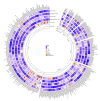Causal association of gut microbes and blood metabolites with acne identified through systematic mendelian randomization
- PMID: 39501024
- PMCID: PMC11538280
- DOI: 10.1038/s41598-024-78603-z
Causal association of gut microbes and blood metabolites with acne identified through systematic mendelian randomization
Abstract
Acne is a prevalent inflammatory disease in dermatology, and its pathogenesis may be associated with inflammation, immunity, and other mechanisms. It commonly manifests in young individuals and frequently imposes a heavy economic, physical, and psychological burden on patients. Gut microbes and blood metabolites, as significant immune and inflammatory regulators in the body, have been hypothesized to form the "neurocutaneous axis." Nonetheless, the precise causal relationships among the gut microbes, circulating blood metabolites, and acne development have yet to be elucidated. This study employed bidirectional two-sample Mendelian randomization (MR) to probe the causal impacts of 412 distinct gut microbes and 249 blood metabolites on acne. Single nucleotide polymorphisms (SNPs), which are closely associated with gut microbes and blood metabolites, were utilized as instrumental variables. This approach was taken to discern whether these elements serve as pathogenic or protective factors in relation to acne. Furthermore, a mediation analysis encompassing gut microbes, blood metabolites, and acne was conducted to explore potential correlations between gut microbes and blood metabolites, as well as their cumulative effects on acne. This was done to substantiate the notion of causality. Bidirectional two-sample MR analysis revealed 8 gut bacteria, 6 bacterial metabolic abundance pathways determined by birdshot, and 8 blood metabolites significantly associated with acne. The mediation MR analysis revealed 2 potential causal relationships, namely, Bifidobacterium-DHA-Acne and Bifidobacterium-Degree of Unsaturation-Acne. This study identified gut microbes and blood metabolites that are causally associated with acne. A potential causal relationship between gut microbes and blood metabolites was obtained via mediation analysis. These insights pave the way for the identification of new targets and the formulation of innovative approaches for the prevention and treatment of acne.
Keywords: Acne; Blood metabolites; Gut microbes; Mediation analysis; Mendelian randomization.
© 2024. The Author(s).
Conflict of interest statement
The authors declare no competing interests.
Figures








Similar articles
-
Mendelian randomization analysis reveals an independent causal relationship between four gut microbes and acne vulgaris.Front Microbiol. 2024 Feb 2;15:1326339. doi: 10.3389/fmicb.2024.1326339. eCollection 2024. Front Microbiol. 2024. PMID: 38371936 Free PMC article.
-
Causal Effects of Gut Microbiota and Metabolites on Chronic Obstructive Pulmonary Disease: A Bidirectional Two Sample Mendelian Randomization Study.Int J Chron Obstruct Pulmon Dis. 2024 Sep 28;19:2153-2167. doi: 10.2147/COPD.S472218. eCollection 2024. Int J Chron Obstruct Pulmon Dis. 2024. PMID: 39360021 Free PMC article.
-
The causal relationship between serum metabolites and acne vulgaris: a Mendelian randomization study.Sci Rep. 2024 May 14;14(1):11045. doi: 10.1038/s41598-024-61850-5. Sci Rep. 2024. PMID: 38744939 Free PMC article.
-
Plasma proteins, circulating metabolites mediate causal inference studies on the effect of gut bacteria on the risk of osteoporosis development.Ageing Res Rev. 2024 Nov;101:102479. doi: 10.1016/j.arr.2024.102479. Epub 2024 Aug 28. Ageing Res Rev. 2024. PMID: 39214170 Review.
-
Genetic liability of gut microbiota for idiopathic pulmonary fibrosis and lung function: a two-sample Mendelian randomization study.Front Cell Infect Microbiol. 2024 May 22;14:1348685. doi: 10.3389/fcimb.2024.1348685. eCollection 2024. Front Cell Infect Microbiol. 2024. PMID: 38841114 Free PMC article.
Cited by
-
Causal Association Between Sleep Deprivation and Glioblastoma Risk: Insights from Multi-Omics Analysis.J Mol Neurosci. 2025 Apr 24;75(2):56. doi: 10.1007/s12031-025-02354-3. J Mol Neurosci. 2025. PMID: 40272711 Free PMC article.
-
No Associations Between Genetically Predicted Chronotype, Insomnia, Daytime Sleepiness, or Physical Activity and Acne Vulgaris: A Two-Sample Mendelian Randomization Study.Clin Cosmet Investig Dermatol. 2025 Apr 6;18:827-835. doi: 10.2147/CCID.S510739. eCollection 2025. Clin Cosmet Investig Dermatol. 2025. PMID: 40225312 Free PMC article.
References
-
- Fan, Y. & Pedersen, O. Gut microbiota in human metabolic health and disease. Nat. Rev. Microbiol.19 (1), 55–71 (2021). - PubMed
-
- O’Neill, C. A., Monteleone, G., McLaughlin, J. T. & Paus, R. The gut-skin axis in health and disease: a paradigm with therapeutic implications. BioEssays: News Reviews Mol. Cell. Dev. Biology. 38 (11), 1167–1176 (2016). - PubMed
MeSH terms
Grants and funding
LinkOut - more resources
Full Text Sources
Medical

